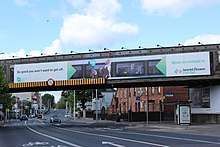North Strand Road
North Strand Road (Irish: Bóthar na Trá Thuaidh) is a street in the Northside of Dublin, Ireland. It links the city centre from Connolly Station to Fairview by road.
 | |
 | |
| Native name | Bóthar na Trá Thuaidh (Irish) |
|---|---|
| Former name(s) | The Strand |
| Namesake | named because it formerly was on the edge of the River Liffey |
| Length | 800 m (2,600 ft) |
| Width | 29 metres (95 ft) |
| Location | Dublin, Ireland |
| Postal code | D03 |
| Coordinates | 53.358525°N 6.241297°W |
| north end | Annesley Bridge Road, Poplar Row, East Wall Road |
| south end | Seville Place, Portland Row, Amiens Street |
Route
North Strand Road is a continuation of Amiens Street, which runs northeast from the junction of Portland Row and Seville Place. It crosses the Royal Canal on the Newcomen Bridge, and proceeds to the junction of East Wall Road and Poplar Row via the Annesley Bridge over the River Tolka; at this point it continues as Annesley Bridge Road.
History
As late as 1673, what is now North Strand Road was under the waters of the River Liffey mouth in Dublin Bay. In 1728 and 1756, the road was noted on maps as "the Strand" and was called by its present name by 1803.
World War II bombing
On the night of 31 May 1941, aircraft of the German Luftwaffe dropped four high-explosive bombs on the North Strand Road area, killing 34 and injuring 90. Three hundred houses were damaged or destroyed.[1][2]
It was not clear if this was a reprisal for the aid of the Dublin Fire Brigade during bombing raids on Belfast or if it had been a tactic to end Irish neutrality.
On 19 June, the Irish government announced that the government of the Nazi Germany had apologised and offered compensation.
Speculation over the reason for the raid has included the possibility that it was the unintended consequence of equipment used to jam radio navigation used by the bombers.
See also
References
- Mark McCarthy (6 May 2016). Ireland's 1916 Rising: Explorations of History-Making, Commemoration & Heritage in Modern Times. Routledge. pp. 169–. ISBN 978-1-317-11287-7.
- Kevin C. Kearns (10 October 2014). The Legendary ‘Lugs Branigan’ – Ireland’s Most Famed Garda: How One Man became Dublin’s Tough Justice Legend. Gill Books. pp. 142–. ISBN 978-0-7171-5937-6.